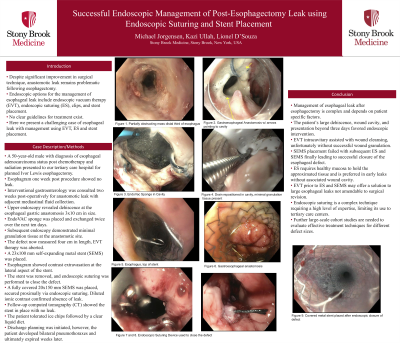Monday Poster Session
Category: Interventional Endoscopy
P2817 - Endoscopic Management of Post-Esophagectomy Leak Using Endoscopic Suturing and Stent Placement
Monday, October 28, 2024
10:30 AM - 4:00 PM ET
Location: Exhibit Hall E

Has Audio

Michael Jorgensen, MD
Stony Brook Medicine
Stony Brook, NY
Presenting Author(s)
Michael Jorgensen, MD, Kazi Ullah, MD, Lionel D'Souza, MD
Stony Brook Medicine, Stony Brook, NY
Introduction: Despite significant improvement in surgical technique, anastomotic leak remains problematic following esophagectomy. Endoscopic options for the management of esophageal leak include endoscopic vacuum therapy (EVT), endoscopic suturing (ES), clips, and stent placement. No clear guidelines for treatment exist. Here we present a challenging case of esophageal leak with management using EVT, ES and stent placement.
Case Description/Methods: A 50-year-old male with esophageal adenocarcinoma status post chemotherapy and radiation presented to our tertiary care hospital for Ivor Lewis esophagectomy. Esophagram one week post procedure showed no leak. Interventional gastroenterology was consulted two weeks post-operatively for anastomotic leak with adjacent mediastinal fluid collection. Upper endoscopy revealed dehiscence at the esophageal gastric anastomosis 3x10 cm in size. EVT was placed and exchanged twice over ten days. Subsequent endoscopy demonstrated minimal granulation tissue at the anastomotic site. The defect now measured four cm in length, thus EVT therapy was aborted. A 23x100 mm self-expanding metal stent (SEMS) was placed.
Esophagram showed contrast extravasation at the lateral aspect of the stent. The stent was removed, and endoscopic suturing was performed to close the defect. A fully covered 20x150 mm SEMS was placed, secured proximally via ES. Both diluted ionic contrast and follow-up computed tomography (CT) confirmed stent placement with absence of leak. The patient tolerated ice chips followed by a clear liquid diet. Discharge planning was initiated, however, the patient developed bilateral pneumothoraces and ultimately expired weeks later.
Discussion: Management of post-esophagectomy leak is complex and depends on patient specific factors. The patient’s large dehiscence, wound cavity, and presentation beyond three days favored endoscopic intervention. Intracavitary EVT facilitated abscess resolution, unfortunately without successful wound granulation. SEMS placement failed with subsequent ES and SEMS finally leading to successful closure of the esophageal defect. ES requires healthy mucosa to hold the approximated tissue and is preferred in early leaks without associated wound cavity. EVT prior to ES and SEMS may offer a solution to large esophageal leaks not amendable to surgical revision. Further large-scale cohort studies are needed to evaluate effective treatment techniques for different defect sizes.
Disclosures:
Michael Jorgensen, MD, Kazi Ullah, MD, Lionel D'Souza, MD. P2817 - Endoscopic Management of Post-Esophagectomy Leak Using Endoscopic Suturing and Stent Placement, ACG 2024 Annual Scientific Meeting Abstracts. Philadelphia, PA: American College of Gastroenterology.
Stony Brook Medicine, Stony Brook, NY
Introduction: Despite significant improvement in surgical technique, anastomotic leak remains problematic following esophagectomy. Endoscopic options for the management of esophageal leak include endoscopic vacuum therapy (EVT), endoscopic suturing (ES), clips, and stent placement. No clear guidelines for treatment exist. Here we present a challenging case of esophageal leak with management using EVT, ES and stent placement.
Case Description/Methods: A 50-year-old male with esophageal adenocarcinoma status post chemotherapy and radiation presented to our tertiary care hospital for Ivor Lewis esophagectomy. Esophagram one week post procedure showed no leak. Interventional gastroenterology was consulted two weeks post-operatively for anastomotic leak with adjacent mediastinal fluid collection. Upper endoscopy revealed dehiscence at the esophageal gastric anastomosis 3x10 cm in size. EVT was placed and exchanged twice over ten days. Subsequent endoscopy demonstrated minimal granulation tissue at the anastomotic site. The defect now measured four cm in length, thus EVT therapy was aborted. A 23x100 mm self-expanding metal stent (SEMS) was placed.
Esophagram showed contrast extravasation at the lateral aspect of the stent. The stent was removed, and endoscopic suturing was performed to close the defect. A fully covered 20x150 mm SEMS was placed, secured proximally via ES. Both diluted ionic contrast and follow-up computed tomography (CT) confirmed stent placement with absence of leak. The patient tolerated ice chips followed by a clear liquid diet. Discharge planning was initiated, however, the patient developed bilateral pneumothoraces and ultimately expired weeks later.
Discussion: Management of post-esophagectomy leak is complex and depends on patient specific factors. The patient’s large dehiscence, wound cavity, and presentation beyond three days favored endoscopic intervention. Intracavitary EVT facilitated abscess resolution, unfortunately without successful wound granulation. SEMS placement failed with subsequent ES and SEMS finally leading to successful closure of the esophageal defect. ES requires healthy mucosa to hold the approximated tissue and is preferred in early leaks without associated wound cavity. EVT prior to ES and SEMS may offer a solution to large esophageal leaks not amendable to surgical revision. Further large-scale cohort studies are needed to evaluate effective treatment techniques for different defect sizes.
Disclosures:
Michael Jorgensen indicated no relevant financial relationships.
Kazi Ullah indicated no relevant financial relationships.
Lionel D'Souza indicated no relevant financial relationships.
Michael Jorgensen, MD, Kazi Ullah, MD, Lionel D'Souza, MD. P2817 - Endoscopic Management of Post-Esophagectomy Leak Using Endoscopic Suturing and Stent Placement, ACG 2024 Annual Scientific Meeting Abstracts. Philadelphia, PA: American College of Gastroenterology.
